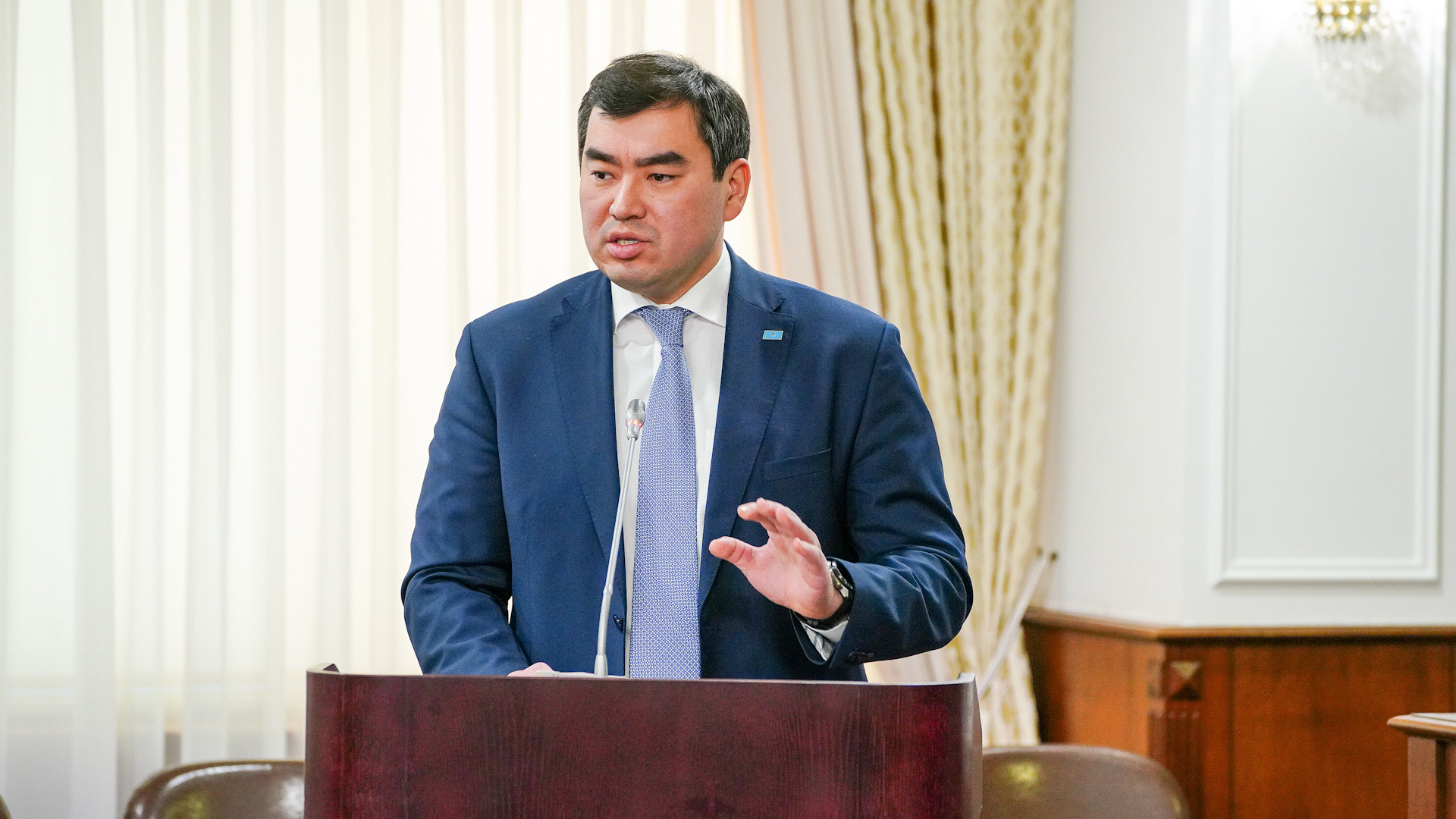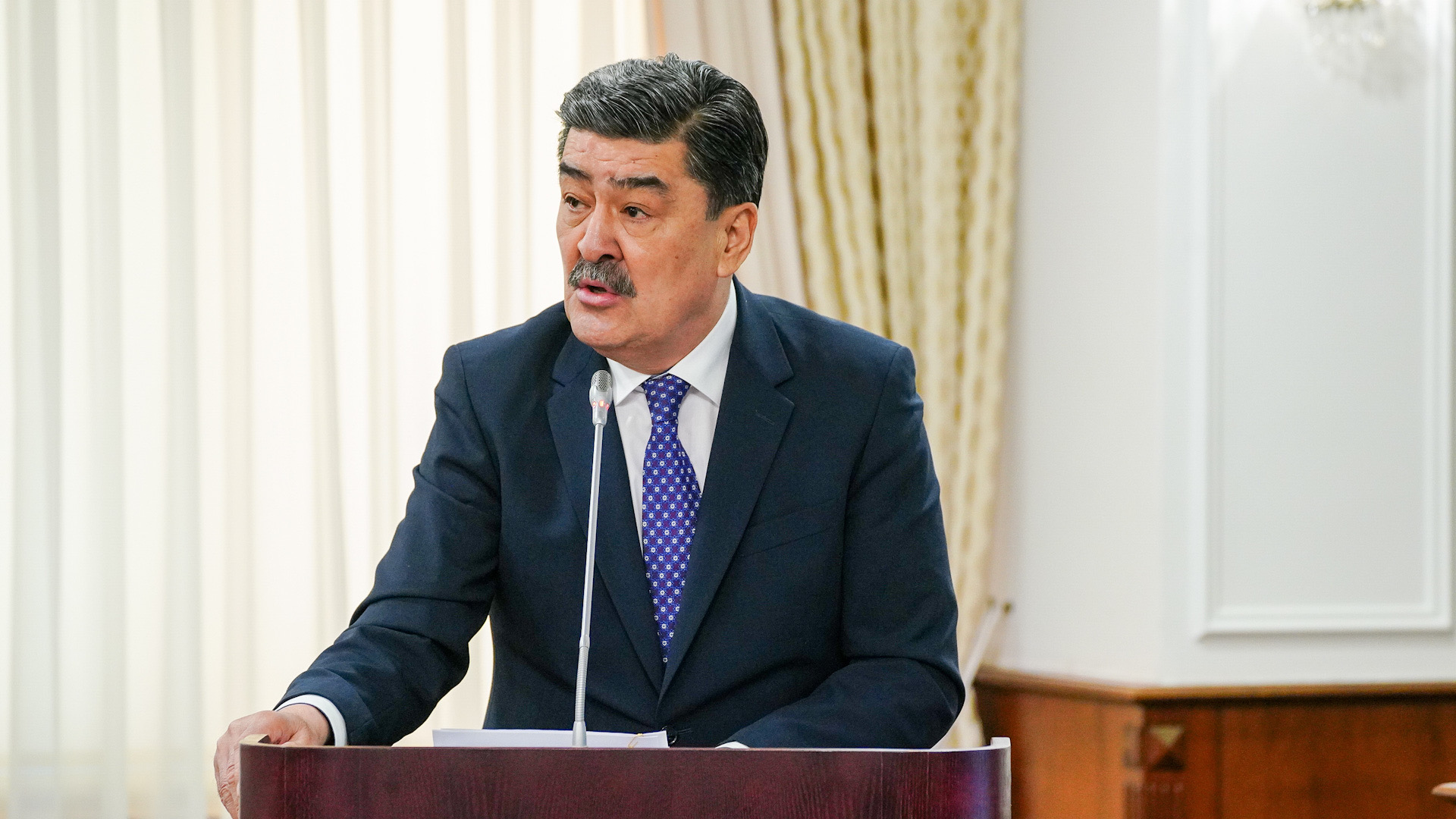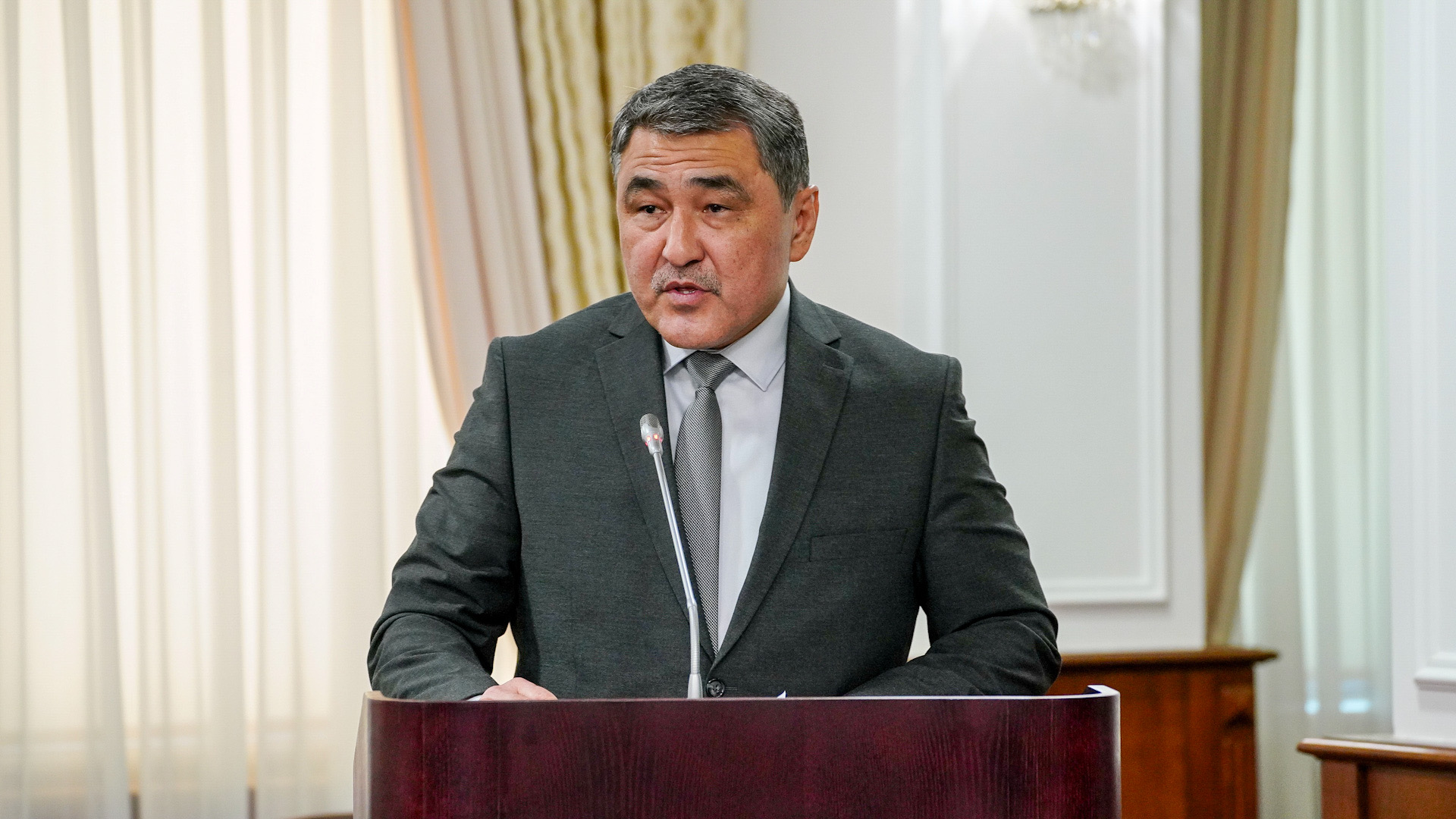20 February 2024, 17:04
 The current flood situation in the country today is relatively stable. At the same time, according to the preliminary forecast of Kazhydromet JSC, at the end of February and in March in the south-eastern, northern and central parts of the country may fall heavy precipitation with a monthly norm per day. Such data at the Government session chaired by Prime Minister Olzhas Bektenov was voiced by the head of the Ministry for Emergency Situations Chingis Arinov.
The current flood situation in the country today is relatively stable. At the same time, according to the preliminary forecast of Kazhydromet JSC, at the end of February and in March in the south-eastern, northern and central parts of the country may fall heavy precipitation with a monthly norm per day. Such data at the Government session chaired by Prime Minister Olzhas Bektenov was voiced by the head of the Ministry for Emergency Situations Chingis Arinov.
In this regard, there are risks of flooding of settlements in 10 regions. Of them due to mountain water runoff in Almaty, Turkestan, East Kazakhstan regions and Zhetisu; due to heavy snow melt in West Kazakhstan, Akmola, North Kazakhstan, Karaganda, Pavlodar and Kostanay regions.
"The Ministry together with local executive bodies carried out the necessary set of measures to prepare for the flood period. In the framework of the republican command and staff exercise "Koktem" checked the actual readiness of forces and means of management bodies. Notification of the population has been practised, and assembly points for citizens have been prepared. Actually implemented the construction of temporary dams and encirclement of settlements (114 km), cleaning of aryks, canals (1,904 km), as well as culverts on roads and railways (5,002 units), from settlements removed more than 10.5 million cubic metres of snow. But, as annual practice shows, this is not enough," the speaker stressed.
According to statistics for the last three years, despite the preventive measures taken, the settlements of Akmola, Kostanay, Pavlodar, West-Kazakhstan, North-Kazakhstan and East-Kazakhstan regions are annually flooded. Given these facts, it is necessary to promptly and more effectively address the issue of protecting the population from flood threats.
"Previously, since 2017, road maps were approved every 3 years. Their implementation showed their effectiveness partially. Most of the activities were not fulfilled and were carried over to the next roadmap. The reason is the lack of proper funding for all envisaged measures. There was only a point reinforcement of individual measures. As a result the last roadmap (2021-2023) was implemented only by 58%, 92 measures were not implemented. Sometimes financial resources for the implementation of individual measures were insufficient due to the increasing cost of projects. And their additional financing took a lot of time," the Minister said.
He added that it is necessary to plan one hundred per cent financing of flood control measures at the local level, Akimats have the relevant competence and mechanism. The measures taken should be effective and not be temporary, in the end it should solve the issues of the regions in the flood period.
"For example, the construction of the Koksarai counter-regulator allowed once and for all to remove the threat of flooding of more than 400 settlements along the Syr Darya River. This year it is planned to build the Yesil counter-regulator on the Yesil River in Akmola region, which will eliminate the threat of flooding of settlements in Akmola and North-Kazakhstan regions. In total, the construction of 40 reservoirs is required in the country. Yes, it will be costly for akimats, but still it will allow to increase safety of the population and reduce social tension from loss of property. At the same time, the issue of irrigation of agricultural lands in the summer period will be solved," Arinov said.
As world practice shows, the amounts allocated for post-liquidation measures are hundreds of times more than the funds that could have been used in advance to prevent emergencies. At the Government session in January, local executive bodies have already been instructed to plan flood control measures in relevant programme documents.
In turn, Chingis Arinov assured that as a coordinating ministry will not abdicate its responsibility to protect the population and will provide all necessary assistance in case of emergencies.
"In recent years, no proper attention has been paid to hydraulic structures, because of their poor stability there are risks of reservoirs bursting and threatening settlements. At the same time, repair works are carried out only on the republican structures, municipal and private ones have been neglected for many years. Today, according to the Ministry of Water Resources and Irrigation, there are more than 1.5 thousand hydraulic structures in the country, of which more than a third require repair," the Minister for Emergency Situations said.
Most of them are located in flood-prone regions. They are in Karaganda, East Kazakhstan, Almaty, Aktobe, Akmola, Abai, Zhambyl, West Kazakhstan and Kostanay regions. Their absence in case of a breakthrough will lead to human casualties, as it happened in 2010 and 2014 in Almaty and Karaganda regions. Immediate threat to life for the population is posed by 304 HS, of which 216 or 71% do not have local warning systems. Low equipment of warning systems in Almaty, Aktobe, Akmola, East Kazakhstan, Karaganda and Kostanay regions.
Every year, through the efforts of the Ministry of Emergency Situations and Akimats, the peak of floods is kept by emergency reinforcement of dozens of protective dams. And notification of the population is carried out almost door-to-door, but these are temporary measures only during the flood period. In general, the situation repeats itself from year to year. The existing problems do not find their solution.
"The Ministry of Water Resources and Irrigation together with akimats need to solve them as soon as possible. There are also problems in the implementation of water regulation in the operation of reservoirs. For example, during my trip to Turkestan province, I visited the Koksarai counter-regulator, which is under the authority of Kazvodkhoz. Now its operability is 50%, in 8 places griffins were formed due to improper operation of the reservoir and untimely release of water. Improper regulation of accumulation and other reservoirs is observed annually from the side of "Kazvodkhoz". In 2022 and 2023, filling of the Shardara counter-regulator was carried out one month earlier than the approved schedule. This could lead to flooding of downstream settlements," the head of the agency pointed out the problem.
He paid special attention to the overflows and washouts of the republican and regional roads during the flood period. This causes negative criticism from the population. For example, every year due to overflows of the road bed communication with settlements in Akmola, Kostanay and Aktobe regions is hampered. Today there are 900 sections of motorways and over 600 sections of railways subject to flooding across the republic.
"The main reason is low capacity or no culverts under roads and railways. As a result, even new roads are being washed away. In this regard, the Ministry of Transport and akimats, when carrying out repair and rehabilitation of roads, need to provide for their laying. Returning to the current situation, it should be noted that 12 facts of flooding of settlements and overflow of roads have already been registered. At the same time, the flood period has not yet begun," the speaker summarised.
In January and February due to sharp temperature fluctuations and heavy snowmelt in East Kazakhstan, West Kazakhstan, Abay, Atyrau and Aktobe regions there were flooding of 15 yard territories, 29 dacha plots, 13 streets and overflow of roads.
The Ministry of Emergency Situations strongly recommends all akimats and interested state bodies to take measures to solve the problems voiced. It is necessary to take measures in advance to reduce flood threats to settlements.
These are timely snow removal, blasting of rivers, bunding of settlements, preparation of equipment and people, inert materials, collection points and appropriate essentials for the population.
 The Minister of Ecology and Natural Resources Yerlan Nysanbayev also reported on the pre-flood hydrometeorological situation in the country.
The Minister of Ecology and Natural Resources Yerlan Nysanbayev also reported on the pre-flood hydrometeorological situation in the country.
As of 10 February 2024, the indicators of moisture in the snow cover on the plain territory were as follows:
above the average annual values:
- in the river basins of Akmola region from 25 to 42%;
- in the Esil river basin of North-Kazakhstan region by 58%;
- in the river basins of Kostanay region from 49 to 120%;
- in the basins of the rivers Wil, Ory and Kosistek in Aktobe region from 25 to 69%.
below the mean annual values:
- in the river basins of Karaganda region from 31 to 61%;
- in the river basins of Ulytau region from 29 to 48%;
- in the Esil river basin upstream of the Astana reservoir in Akmola region by 24%;
- in the basins of the Karatorgai and Torgai rivers in Kostanai region from 15 to 23%;
- in the basins of the Ilek, Temir and Irgiz rivers in Aktobe province from 17 to 52%;
- in river basins of West Kazakhstan region from 13 to 55%;
- in river basins of Atyrau region by 54%.
Within the mean annual values are observed in the river basins of Seleta in Akmola region and Kargaly in Aktobe region.
According to the data of high-mountain snow measurement routes as of 1 February 2024 in the mountainous part of the country, the situation with regard to snow accumulation was as follows:
- above average annual values from 22 to 66% in mountainous areas of East Kazakhstan region and Abay.
- below mean annual values from 34 to 73% in the mountains of Turkestan, Zhambyl, Almaty regions and Zhetisu region.
- within average annual values in zones of South-Western slope of Tarbagatai ridge of East Kazakhstan and Abai regions and in basins of Arys and Zhabaglysu rivers of Turkestan region.
Indicators of autumn soil moistening in the current year on the whole plain territory of the country are higher than average annual values:
- from 30 to 151% in the river basins of Akmola and North-Kazakhstan regions;
- from 34 to 180% in the river basins of Kostanay region;
- from 61 to 161% in the river basins of Atyrau and Aktobe regions;
- 71 to 133% in the river basins of West Kazakhstan region;
- from 74 to 163% in the river basins of Karaganda and Ulytau regions;
The exception is the Tokyrau river basin, located in the arid zone of Karaganda region, autumn soil moisture was 55 mm, which exceeds the norm by 6 times. This river will be on constant monitoring.
At the same time, the depth of soil freezing is higher than last year's figures from 5 to 35 cm in the basin of the river Or in Aktobe region and Tokyrau in Karaganda region. In the other basins of the country's plains, the soil freezing depth is below last year's figures on average from 2 to 91 cm.
"Taking into account the above factors, in case of a sharp increase in temperature background and heavy rains in February and March may occur talo-rain floods," the Minister noted and separately voiced data on the synoptic forecast in the third decade of February.
Precipitation in most parts of the country is expected in the form of snow, while in the south of the country precipitation is expected in the form of rain and wet snow. According to the preliminary forecast, the average monthly air temperature in March is expected to be about normal in most parts of the country, above normal by 1° in the east, south-east and south of the country. The amount of precipitation in March is forecast to be above normal in most of the country, near normal in the southwest, northwest and north of RK
"By analysing the values of precipitation, water reserves in snow, indicators of autumn soil moisture, soil freezing depth, presence of ice crust on the soil surface, as well as ice regimes of rivers, a preliminary assessment of flood-prone regions is given. With increased risks - Karaganda, Ulytau, Akmola, North-Kazakhstan, Kostanay, East-Kazakhstan, Abay, Aktobe, West-Kazakhstan, Atyrau, Almaty and Turkestan regions. Regions with medium risks - Zhetisu, Zhambyl and Pavlodar regions," the minister summarised.
The main forecast for the flood period "Kazhydromet" will provide until 5 March this year, further forecasts will be provided weekly.
In case of sharp changes in hydrological and meteorological conditions "Kazhydromet" will notify by storm warnings about the risks of flood threats 2-3 days in advance.
 During the flood period, the Ministry of Water Resources and Irrigation constantly monitors the filling of reservoirs. The percentage of filling is displayed, and the information received on inflow and water discharge from reservoirs is analysed. This year before the beginning of the flood period on the main reservoirs created free reservoirs for safe reception of flood waters. This was reported by the head of the department Nurzhan Nurzhigitov.
During the flood period, the Ministry of Water Resources and Irrigation constantly monitors the filling of reservoirs. The percentage of filling is displayed, and the information received on inflow and water discharge from reservoirs is analysed. This year before the beginning of the flood period on the main reservoirs created free reservoirs for safe reception of flood waters. This was reported by the head of the department Nurzhan Nurzhigitov.
On the reservoirs of republican ownership the average free capacity is - 50%, on communal and private - 60%.
"It should be noted that the operation of water management facilities is ensured by compliance with instructions and other documents that ensure safe operation of water management facilities. Rules for operation of reservoirs are developed individually for each reservoir depending on its design values," the speaker said.
To date, all reservoirs operate in the accumulation mode. In the northern regions, the average accumulation of reservoirs is 8$, which is 7% more than last year. In the southern regions, the average accumulation of reservoirs is 46%. In the western regions, the average accumulation of reservoirs is 57%, which is 17$ more than last year. For the eastern regions, the average accumulation of reservoirs is 75%, which is 3% more compared to last year's indicators. In central Kazakhstan average accumulation of reservoirs is 66%. In general, the situation on filling of reservoirs is stable and is under constant control.
"On all 1502 retaining hydraulic structures specialists of basin inspections together with departments for emergency situations, local executive bodies, as well as owners of HS conducted annual visual inspections, according to the results of which 537 require repair. In addition, in accordance with the requirements of water legislation, owners of HS are obliged to conduct a multi-factor survey to determine the instrumental condition of HS and to conduct a declaration of safety," the Minister said.
Thus, as of 1 February 2024, out of the available 1502 HS, multifactor examination was carried out on 118 HS, including the republican ownership 32, communal ownership 79, private 7. Also, 115 safety declarations were registered in basin inspections, including 49 of republican ownership, 52 of communal ownership and 14 of private ownership.
Akimats of Abay, Ulytau and Zhetisu regions, as well as Almaty, Aktobe, Karaganda, Kostanay, Kyzylorda, Pavlodar, Turkestan, North-Kazakhstan regions did not conduct multifactor surveys on HS of municipal and private ownership. Therefore, these akimats need to take urgent measures. Also on ownerless HS Akimats of Almaty (4 objects), Pavlodar (1 object) and Karaganda (4 objects) regions need to finalise procedures for their acceptance on the balance of municipal property.
"In order to prepare for the flood period for prompt response and analysis under the Ministry created a flood control commission and operational headquarters, as well as on the basis of branches of RSE "Kazvodkhoz" regional flood control commissions were created. In case of emergencies subdivisions of RSE "Kazvodkhoz" have prepared the necessary reserves of inert materials," the head of the ministry reported.
Transport Minister Marat Karabayev told about the measures taken within the framework of preparation of roads and railways for the flood period.
 On the republican roads 396 flood-prone areas, 68 bridges and 650 culverts have been identified. Round-the-clock duty and daily patrolling has been organised.
On the republican roads 396 flood-prone areas, 68 bridges and 650 culverts have been identified. Round-the-clock duty and daily patrolling has been organised.
In order to promptly take measures during the flood period, all regions are preparing the necessary inert and other materials. At the moment, 10 thousand cubic metres of sand, 3 thousand cubic metres of rubble, 2 thousand cubic metres of crushed stone, 12 thousand cubic metres of GGS and 49 thousand bags have been prepared. In order to ensure the passage of melt water, depending on weather conditions, work is carried out to open and clean culvert openings from snow.
As part of the reconstruction of motorways in flood-prone areas, work is carried out on:
- additional construction of artificial structures;
- increasing the diameter of culverts and their number;
- increasing the height of the earth bed embankment.
"It should be noted that the measures taken allow preventing destruction of road sections and ensuring safe passage of vehicles. Over the past 3 years, the number of flood-prone areas has decreased by 20%. In the railway sector, KTZ, a national company, has approved the order "On preparation of track and artificial structures for the passage of icebreaker and flood waters". Within the framework of the order, measures are taken to ensure sustainable operation of the track and artificial structures in the flood period," the head of the department said.
To take measures during the flood period, about 2.6 thousand cubic metres of rubble stone and more than 8 thousand substandard reinforced concrete sleepers, 17 inventory metal spans, 45 inventory rail packages, 145 pipes have been prepared. 45 anti-scour trains are being formed.
#Ecology #Floods #Government session #Ministry for Emergency Situation #Transport #water resourcesStay updated about the events of the Prime Minister and the Government of Kazakhstan - subscribe to the official Telegram channel
Subscribe